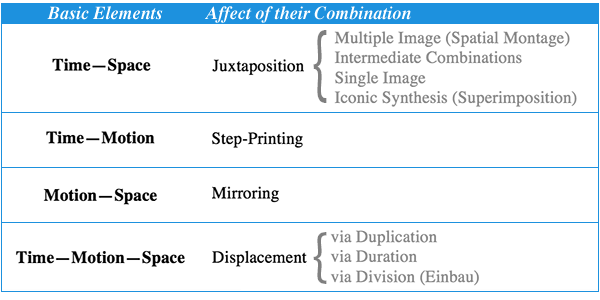PORTFOLIO |
 |
|
|
|
|
|
 |
 |
"Beyond Spatial Montage" part 2 of 6
story © Michael Betancourt | published November 10, 2014 | permalink |



 |
| 
|
 |


|
 |
|
This theory work will be published as a book-length monograph Beyond Spatial Montage: Windowing, or, the Cinematic Displacement of Time, Motion, and Space by Focal Press.
Part 2 of a 6 Part series proposing an expanded theorization of spatial montage, excerpted from a current book project.
The technologies of compositing and image combination directly contribute to the development of juxtaposed imagery. While the production of composite imagery is evident in the history of motion pictures since the first Trik films were made in the 1890s, the relative rarity of these images�even within the Trik film�remained relatively constant due to the difficulties of their production. The greatly reduced costs, coupled with relative ease of production with digital video has made the integration of live action, animation and graphic design via compositing a common feature of motion graphics and commercials even though it remains relatively unusual in narrative production.

The distinction between different potentials within the range of these forms is a function of the on-screen affect of the materials combined. For narratives with live actors and edited sequences of shots, these potentials have a more limited application. The apparent division and fragmentation of the screen into smaller, discrete units in narrative works remains unusual even as similar forms appear more frequently in the commercials and title sequences accompanying these realist fictions.
|

|
|
read more (1967 words)
|

|
| |
 |
"Beyond Spatial Montage" part 1 of 6
story © Michael Betancourt | published November 4, 2014 | permalink |



 |
| 
|
 |


|
 |
|
This theory work will be published as a book-length monograph Beyond Spatial Montage: Windowing, or, the Cinematic Displacement of Time, Motion, and Space by Focal Press.
Part 1 of a 6 Part series proposing an expanded theorization of spatial montage, excerpted from a current book project.
Foundations Links Between Time, Motion, and Space
The typical cinematic image (either in long take or montage form) appears in the absence of additional constraints: the �pure� form of Motion is the long take (undisplaced movement contained by the long take); montage/editing are each a �pure� form of Temporal displacement, apparent through the ruptures created by the cut; the �pure� form of Spatial displacement lies with the use of multiple projection�a use that forms a range lying between apparently discrete screens and the composite screen produced by aligning the edges of one projector with another as in cinemascope or Able Gance�s Napoleon. Distinguishing between time, motion, and space in a theoretically precise manner allows for a more robust theorization of windowing: the distinction between one dimension and another is instantly apparent in the affect resulting from watching the motion picture itself. Each of these dimensions can be readily distinguished from the others through our encounter with it on screen: the affect it has determines its location within this taxonomy.
|

|
|
read more (1657 words)
|

|
| |

|
| |
|
|
|